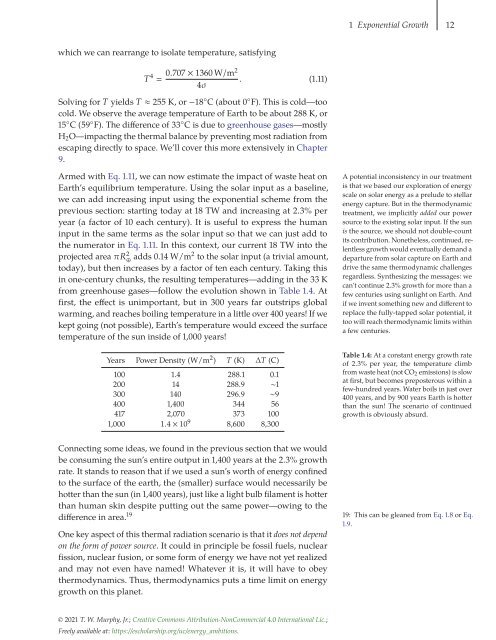Energy and Human Ambitions on a Finite Planet, 2021a
Energy and Human Ambitions on a Finite Planet, 2021a
Energy and Human Ambitions on a Finite Planet, 2021a
Create successful ePaper yourself
Turn your PDF publications into a flip-book with our unique Google optimized e-Paper software.
1 Exp<strong>on</strong>ential Growth 12<br />
which we can rearrange to isolate temperature, satisfying<br />
T 4 <br />
0.707 × 1360 W/m2<br />
. (1.11)<br />
4σ<br />
Solving for T yields T ≈ 255 K, or −18 ◦ C (about 0 ◦ F). This is cold—too<br />
cold. We observe the average temperature of Earth to be about 288 K, or<br />
15 ◦ C (59 ◦ F). The difference of 33 ◦ C is due to greenhouse gases—mostly<br />
H 2 O—impacting the thermal balance by preventing most radiati<strong>on</strong> from<br />
escaping directly to space. We’ll cover this more extensively in Chapter<br />
9.<br />
Armed with Eq. 1.11, we can now estimate the impact of waste heat <strong>on</strong><br />
Earth’s equilibrium temperature. Using the solar input as a baseline,<br />
we can add increasing input using the exp<strong>on</strong>ential scheme from the<br />
previous secti<strong>on</strong>: starting today at 18 TW <str<strong>on</strong>g>and</str<strong>on</strong>g> increasing at 2.3% per<br />
year (a factor of 10 each century). It is useful to express the human<br />
input in the same terms as the solar input so that we can just add to<br />
the numerator in Eq. 1.11. In this c<strong>on</strong>text, our current 18 TW into the<br />
projected area πR 2 ⊕ adds 0.14 W/m2 to the solar input (a trivial amount,<br />
today), but then increases by a factor of ten each century. Taking this<br />
in <strong>on</strong>e-century chunks, the resulting temperatures—adding in the 33 K<br />
from greenhouse gases—follow the evoluti<strong>on</strong> shown in Table 1.4. At<br />
first, the effect is unimportant, but in 300 years far outstrips global<br />
warming, <str<strong>on</strong>g>and</str<strong>on</strong>g> reaches boiling temperature in a little over 400 years! If we<br />
kept going (not possible), Earth’s temperature would exceed the surface<br />
temperature of the sun inside of 1,000 years!<br />
Years Power Density (W/m 2 ) T (K) ΔT (C)<br />
100 1.4 288.1 0.1<br />
200 14 288.9 ∼1<br />
300 140 296.9 ∼9<br />
400 1,400 344 56<br />
417 2,070 373 100<br />
1,000 1.4 × 10 9 8,600 8,300<br />
A potential inc<strong>on</strong>sistency in our treatment<br />
is that we based our explorati<strong>on</strong> of energy<br />
scale <strong>on</strong> solar energy as a prelude to stellar<br />
energy capture. But in the thermodynamic<br />
treatment, we implicitly added our power<br />
source to the existing solar input. If the sun<br />
is the source, we should not double-count<br />
its c<strong>on</strong>tributi<strong>on</strong>. N<strong>on</strong>etheless, c<strong>on</strong>tinued, relentless<br />
growth would eventually dem<str<strong>on</strong>g>and</str<strong>on</strong>g> a<br />
departure from solar capture <strong>on</strong> Earth <str<strong>on</strong>g>and</str<strong>on</strong>g><br />
drive the same thermodynamic challenges<br />
regardless. Synthesizing the messages: we<br />
can’t c<strong>on</strong>tinue 2.3% growth for more than a<br />
few centuries using sunlight <strong>on</strong> Earth. And<br />
if we invent something new <str<strong>on</strong>g>and</str<strong>on</strong>g> different to<br />
replace the fully-tapped solar potential, it<br />
too will reach thermodynamic limits within<br />
a few centuries.<br />
Table 1.4: At a c<strong>on</strong>stant energy growth rate<br />
of 2.3% per year, the temperature climb<br />
from waste heat (not CO 2 emissi<strong>on</strong>s) is slow<br />
at first, but becomes preposterous within a<br />
few-hundred years. Water boils in just over<br />
400 years, <str<strong>on</strong>g>and</str<strong>on</strong>g> by 900 years Earth is hotter<br />
than the sun! The scenario of c<strong>on</strong>tinued<br />
growth is obviously absurd.<br />
C<strong>on</strong>necting some ideas, we found in the previous secti<strong>on</strong> that we would<br />
be c<strong>on</strong>suming the sun’s entire output in 1,400 years at the 2.3% growth<br />
rate. It st<str<strong>on</strong>g>and</str<strong>on</strong>g>s to reas<strong>on</strong> that if we used a sun’s worth of energy c<strong>on</strong>fined<br />
to the surface of the earth, the (smaller) surface would necessarily be<br />
hotter than the sun (in 1,400 years), just like a light bulb filament is hotter<br />
than human skin despite putting out the same power—owing to the<br />
difference in area. 19<br />
One key aspect of this thermal radiati<strong>on</strong> scenario is that it does not depend<br />
<strong>on</strong> the form of power source. It could in principle be fossil fuels, nuclear<br />
fissi<strong>on</strong>, nuclear fusi<strong>on</strong>, or some form of energy we have not yet realized<br />
<str<strong>on</strong>g>and</str<strong>on</strong>g> may not even have named! Whatever it is, it will have to obey<br />
thermodynamics. Thus, thermodynamics puts a time limit <strong>on</strong> energy<br />
growth <strong>on</strong> this planet.<br />
19: This can be gleaned from Eq. 1.8 or Eq.<br />
1.9.<br />
© 2021 T. W. Murphy, Jr.; Creative Comm<strong>on</strong>s Attributi<strong>on</strong>-N<strong>on</strong>Commercial 4.0 Internati<strong>on</strong>al Lic.;<br />
Freely available at: https://escholarship.org/uc/energy_ambiti<strong>on</strong>s.


















